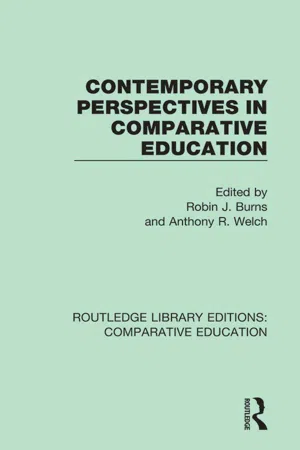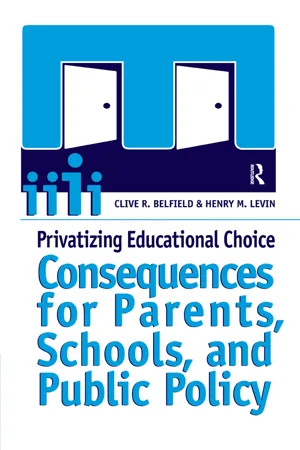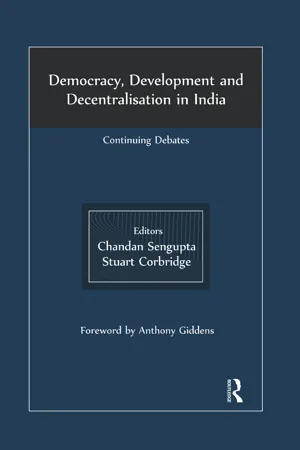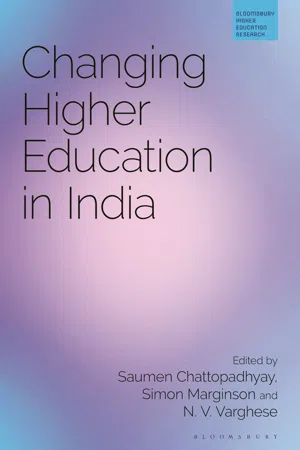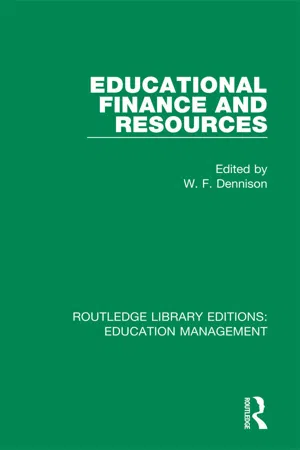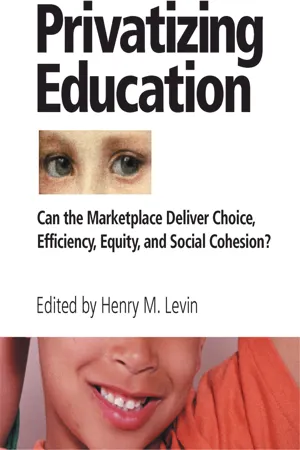Social Sciences
Privatisation of Education
Privatisation of education refers to the transfer of control and ownership of educational institutions from the public sector to the private sector. This can involve the funding, management, and delivery of education by private entities. Proponents argue that it can improve efficiency and quality, while critics raise concerns about equity, access, and the commodification of education.
Written by Perlego with AI-assistance
Related key terms
8 Key excerpts on "Privatisation of Education"
- Robin Burns, Anthony Welch, Robin J. Burns, Anthony R. Welch(Authors)
- 2018(Publication Date)
- Routledge(Publisher)
Crisis is also seen to exist in other social institutions as well, suggesting that solving the educational aspects will contribute to wider change, especially in the economy. The next section of this chapter argues that through the almost exclusive linkage of education and the economy, mediated through limited notions of development, the economically useful aspects of education have been reified as the only legitimate social function which it serves. It is only a short step, therefore, to the third level of discourse which considers education as a commodity, subject to the same forces as other commodities even though a subset, ‘services’, is recognised. If education is so redefined, then privatisation of the service is an obvious step in a capitalist, free market economy, the only decision that the state has to make being how much support to give it.Allocation of educational resources has been a responsibility for the state since its acceptance of a role in the formal process. The difference, it is argued, is that when education becomes a service which is exchanged like other commodities, the change from a normative to an instrumental basis for considering the various elements of education delegitimates or at least places a lower value on other discourses, including the pedagogical, ethical and cultural. It is here, rather than in the debates about quantity and quality, that the true educational, political and socio-cultural crisis lies, posing problems for the very concept of the state especially where there is still a surface allegiance to a social-democratic ideology (Camilleri 1986). These issues will be illustrated through an examination of the privatisation of higher education.EDUCATIONAL CRISIS IN THE 1980S Consideration of the educational crisis has focussed on issues of quantity, quality and their inter-relationships.1. Educational quantityIn the history of the development of educational provision, periods of expansion and non-expansion can be discerned. What triggers the change from one period to another? If we take the beginning of the modern industrial revolution as a starting point, the whole pressure for mass education can be seen as intervention on the part of the state in ‘“managing” the transition from child to worker’ (Clarke and Willis 1984: 8). It is the future worker who is central, and the needs of the employers and their concerns which are uppermost not only in the extension of schooling to new categories of children but in the nature of that schooling. Other justifications may be used, for example “doing something” for the children’s moral and even individual development, especially with the introduction of laws prohibiting child labour, and with the general welfare concerns that enabled such laws to be enacted. But practice comes to be based on anticipated pragmatic outcomes.- eBook - ePub
- Fazal Rizvi, Bob Lingard, Risto Rinne, Fazal Rizvi, Bob Lingard, Risto Rinne(Authors)
- 2022(Publication Date)
- Routledge(Publisher)
The privatization of education has the gift of ubiquity. It is simultaneously a globalizing and a highly contextual phenomenon. The diversity of pathways toward education privatization that we have shown in this chapter is largely reflected in the variegated objectives sought by pro-private sector policies in education. To a great extent, education privatization models vary significantly depending on why, by whom and under which circumstances pro-privatization policies and instruments have been adopted. Nonetheless, privatization trends do not follow a clear-cut pattern in terms of conventional institutional variables, such as types of welfare regimes or governmental ideologies. The fact that the most drastic pro-market reforms in education have been adopted by countries with both (neo)liberal and social-democratic welfare state traditions, as Chile and Sweden respectively have, illustrates well this idea.Regardless of their social and political origins, education privatization policy frameworks are constantly moving, something that adds an additional layer of complexity to the study of the phenomenon. Continuous processes of problematization are key to understand this dynamic. Four decades after the emergence of privatization in the global education agenda, there is consensus on the numerous risks that the penetration of private actors and market principles in education pose to equity. Independently of the model, it is increasingly clear that privatization policies across the board tend to reproduce educational inequities—and that, more often than not, they directly lead to the exacerbation of social class division and the erosion of social cohesion. This is so as the coexistence of public and private subsidized schools, and the expansion of school choice that frequently complements PPP arrangements, is conducive to higher levels of social stratification between schools, and leads to an inequitable distribution of school resources. In response to these concerns, the idea that the ultimate impact of privatization policies depends largely on the specifics of certain policy options and regulations has also been gaining ground. It is increasingly assumed that more effective public regulations could prevent privatization and pro-market policies from undermining equity. Indeed, as we have shown in this chapter, many governments have reformed their PPPs in order to mitigate phenomena such as school segregation. In most cases, these calibration processes have consisted of increasing the role of the state while curtailing the role of the market in the governance of education. - eBook - ePub
Privatizing Educational Choice
Consequences for Parents, Schools, and Public Policy
- Clive R Belfield, Henry M. Levin(Authors)
- 2015(Publication Date)
- Routledge(Publisher)
Chapter 1Education Privatization in Its Many Forms
Introduction
Educational privatization has emerged as a central topic of educational policy in the twenty-first century. More specifically, it has arisen in the form of new initiatives that have been proposed for funding education such as educational vouchers and tuition tax credits as well as methods of providing public support for private schooling. Most observers have at least some opinion on the subject, although accurate information on what is meant by privatization is much scarcer. A major public opinion poll found that about 80 percent of those questioned clearly favored or opposed educational vouchers, a particular approach by which government would fund private school tuition (Public Agenda, 1999). But only about one-third of the respondents could provide even a simple description of educational vouchers. This book represents an attempt to broaden knowledge and understanding of educational privatization by demonstrating its diverse forms and consequences. It is important to note that we are neither advocates nor opponents of educational privatization. We both have a strong belief that policy on the subject needs to be informed by knowledge and understanding rather than emotions and symbolism. Thus, this book is written in the spirit of an attempt at balanced analysis on a controversial subject.In most industrialized countries of the world, including the United States, elementary and secondary education is an official responsibility of government. This commitment has been met by establishing elementary and secondary schools that are sponsored and funded by the government with compulsory attendance requirements for all young persons of a certain age group, for example, ages 6–16. Although private schools and other forms of private instruction have existed prior to public schools almost everywhere, and continue to exist, even these are regulated by governments. - eBook - ePub
Democracy, Development and Decentralisation in India
Continuing Debates
- Chandan Sengupta, Stuart Corbridge(Authors)
- 2013(Publication Date)
- Routledge India(Publisher)
2 The rising trend in the growth of the total number of institutions in the face of dwindling allocation of public resources captures the rising importance of the private sector in the provision of higher education — particularly for professional market-oriented courses. The following section highlights issues around privatisation in further detail.Privatisation of Higher Educational Institutions: An Overview
Privatisation can be broadly viewed as means by way of which the burden of financing higher education can be passed onto non-governmental entities. The privatisation of tertiary education in India has been advocated on the basis that, as a result of dwindling resources, the strain on public resources has seriously undermined the efficiency of the higher education system with regards to quality, accessibility and also infrastructure. Not only are resources limited but much of what is available is committed to salary costs for teachers (particularly after the Fifth Pay Commission revision of salaries for university and college teachers) and other such recurring expenses.Moreover, as mentioned earlier, the reduction of government subsidies for ‘higher education’ has also been supported on theoretical grounds, with arguments such as that the subsidisation of education, particularly of higher education, could have regressive effects (Khadria 2003; Tilak 2004a, 2004b). Generally, education is subsidised through indirect taxes, which are largely paid by relatively poorer families while relatively rich individuals mainly utilise higher educational services. Higher education equips the students with higher productivity and hence, with higher lifetime earnings. In other words, higher education generates private human capital and does not enhance social capital. Consequently, subsidisation is not economically meaningful. Such arguments feed into the debate of recent years, placing greater onus on higher education institutions to generate finance for their expenses. As observed by the Central Advisory Board of Education (CABE) in 2005 in confirmation of structural adjustment policies, privatisation of the Indian higher education sector has broadly assumed two forms: - eBook - ePub
- Saumen Chattopadhyay, Simon Marginson, N. V. Varghese, Saumen Chattopadhyay, Simon Marginson, N. V. Varghese(Authors)
- 2021(Publication Date)
- Bloomsbury Academic(Publisher)
The argument in favour of dominant role of public investment in higher education was more appealing when state-led growth was the preferred strategy of development than during a period of market-led globalization. During the globalization stage, the private universities have been proliferating across globe, particularly in developing countries. Half a century ago, there were very few countries with private universities; at present, there are very few countries without them. Further, private institutions of higher education are growing faster thereby increasing their share in institutions and improving their share in student enrolments.3. Privatization and the Private Sector in Higher EducationThe state played an important role in the development strategy in the post-Second World War period. This model worked well during the reconstruction phase in Europe and during the postcolonial period in the developing countries. The public universities and state funding became the dominant feature of higher education development in most countries. The state-dominated model of higher education development was questioned in the 1980s by the changing ideological orientation and neoliberal thinking. The argument was for a reduced public investment in education in general, and a diversion of public investment from higher to primary education in developing countries in particular (World Bank 1986 ; Banya and Elu 2001 ). The emerging neoliberal reform measures manifested mostly through two phenomena: privatization of public institutions and promotion of private higher education institutions (Varghese 2004 ).Privatization implies applying market principles in the functioning of public institutions of higher education. The ownership and management of the institutions remain with the public authorities while the operating principles centre around market ideology. Privatization is very often facilitated through transferring the governance to universities (autonomy) and many of them becoming public enterprises venturing into cost recovery, income generating, and for-profit activities (Kezar, Chambers and Burkhardt 2005 ). In the process, many public universities became managerial in their approach and entrepreneurial in their operations (Varghese 2013 ).The higher education developments in Europe, notably in UK, and Australia are good examples of privatization of public institutions. Australia follows a policy of ‘public privatization’ wherein cost-recovery measures are introduced in public universities. The fee levels in UK are not only high but also comparable with that in the private institutions. The UK also follows a differential fee structure whereby non-EU students pay higher tuition than the EU students. The United States have one of the highest tuition fees among OECD countries and is the most expensive system with annual fees exceeding USD 8,000 a year in public universities and more than USD 20,000 in private institutions (OECD 2017 - eBook - ePub
- W. F. Dennison(Author)
- 2018(Publication Date)
- Routledge(Publisher)
Yet, such an outlook has to be placed in the context of the need for more education in a rapidly changing technological environment. The key question of how this is to be achieved, both in relation to quality and quantity, has to be answered. The fact of growing MSC involvement in comparison to a decline in traditional education activity both demonstrates the ineffectiveness of the current lobby to increase the flow of resources through the territorial hierarchy, and raises queries about the extent to which many MSC programmes represent crisis management. In the main they do not include systematic attempts to raise the general level of skill, knowledge and ability in the population. Yet, if the public sector cannot support a sufficiently high level of funding, if the education service can only provide a dynamic and responsive system through acquiring more resources, and if the privatization of activities on a large scale does not appear viable (for whatever reasons), is there any other alternative? Could, perhaps, firms and organizations be persuaded, through some form of privatization, to supply an adequacy of skills and adaptability in the workforce, and by this facilitate economic growth? Previous experience with the necessity of more public intervention in the 1960s and 1970s would suggest that this is unlikely. Perhaps, the only solution to this huge range of problems lies with a different form of privatization. At the nub of all these inter-related issues is the fact that education has become dominated by an institutional basis, which exaggerates many of its demands for resources and produces the inflexibilities in resource deployment that have dominated much of the book. With a less prominent institutional framework it seems more than likely that a much greater volume of education activity could be generated with the same level of resources. In other words, the privatization centres around the individualization of client needs, and the adoption of the most appropriate means for their satisfaction: but not necessarily within a standard course, nor as part of the programme of a conventional school or college. It is the aggregate of all activities in relation to their purposes, which matter, not where they occur. It would be a slow process of gradual modifications to existing practices, but the technological changes which have created so many of the underlying problems may in time also provide solutions. The development of computer soft-ware packages, and the availability of effective communication modes, being the two most obvious examples. Obviously, any attempt to further reduce the institutional bias of publically provided education would be strongly resisted, but such a transformation provides the only viable route towards the regeneration of the education system, and through that sustained economic expansion in a technologically advanced society.NOTES AND REFERENCES
1 DES, Costing educational provision for the 16–19 age group , (1981)2 CMND 7746, The government’s expenditure plans 1980–81 , (1979)3 E.S. Savas, Privatising the Public Sector : How to Shrink Government , (Chatham House, Chatham, New Jersey, 1982)4 A.K. Maynard, Experiments with choice in education: an analysis of consumer financing to bring more resources into education by vouchers and loans - eBook - ePub
Education, Ethics and Experience
Essays in honour of Richard Pring
- Michael Hand, Richard Davies(Authors)
- 2015(Publication Date)
- Routledge(Publisher)
To return to Pring’s thought experiment, if we were behind the veil of ignorance and aware of such realities of life in the world beyond the veil, then I suggest, not knowing where we might end up, we would not be as sanguine as Pring is about public education, but would rather be pleased that the privatised alternative is available. From behind the veil, a privatised system of education, at least in certain contexts, would seem a desirable option, given the realities that exist in these contexts.We’d probably want one caveat here. We’d want to know that, if our families were the very poorest of the poor, unable to afford even low fees, then there could be some assistance to enable us to attend private schools. In which case, targeted vouchers for the poorest or most disadvantaged groups would need to supplement the market system in order to satisfy us, from behind the veil, that the privatised system could work for us. Such targeted vouchers have been shown to work to provide educational opportunities for the poorest groups (Day Ashley et al., 2014 ).However, Pring has brought forward a range of objections to privatisation: do his objections impinge upon this discussion of grassroots privatisation? The first objection concerns the public good of education.Objections to privatisation: the public good of education
Pring writes of the ‘public value’ of education, which ‘lies in the reduction of discrimination, crime, poverty and ill-health’ (Pring, 2013 , p.37). This, he says, ‘contrasts with a view of education as essentially a personal and “positional” good, reflected in the predominant emphasis on parental choice’ (ibid.). Similarly, ‘Society at large has an interest in its schools because the health of each depends on the health of all – upon a sense of community and citizenship, to be nurtured through common experiences and a common culture’ (ibid., p.154).That is, education is important because of the societal benefits it brings, over and above any benefits to individuals. Pring implies that this is an area of disagreement with market theorists, but, in fact, it is not at all. Indeed, these societal benefits, historically, were one of the two sets of justifications given by classical liberal theorists for governments to intervene in education (the other being the protection of minors principle). In classical liberal circles these societal benefits tend to be called ‘neighbourhood effects’ or ‘externalities’, and the fact that education, has, or is likely to have, important externalities is the major reason today why market theorists know that they have to look seriously at justifications for government intervention in education (Tooley, 2008 , 1995 - eBook - ePub
Privatizing Education
Can The School Marketplace Deliver Freedom Of Choice, Efficiency, Equity, And Social Cohesion?
- Henry Levin(Author)
- 2018(Publication Date)
- Routledge(Publisher)
The presumption that government bureaucracies will provide more jobs for adults in poor communities should be examined. Public school bureaucracies may be the largest employers in many poor communities, but such employment is typically at the level of support personnel; higher-paid professional teachers and administrators live elsewhere. Private providers may hire the same kinds of support staff from local communities, and if private providers develop approaches to the provision of educational services that rely less upon professionals for instruction, they may actually hire more people from the local community either as additional support personnel or as less highly credentialed and more technically oriented instructional staff. Moreover, a market for the private provision of educational services may engender entrepreneurial activity among at least some members of the local community. All of these possibilities might be considered in a research agenda on privatization.The interests of poor children and their families in seeking a quality education, and the reliance of any system that enhances parental choice in a marketplace of private providers on such quality-seeking interests, raises the question of what constitutes "quality" for parents and children, particularly poor parents and their children. Parents and children may have various interests in schooling and so may seek different experiences and outcomes. Some may pursue the kinds of academically oriented outcomes increasingly reflected in state and federal policy initiatives. Others may seek affiliation with particular groups, and still others may view schooling as a way to pursue other agendas. Understanding the variety of parents' and students' conceptions of "quality" is an important building block for any studies that seek to assess the extent to which vouchers and privatization lead to higher-quality education. Similarly, understanding the conceptions of quality that motivate public educational bureaucracies and the professionals who staff them is an essential starting place for the design of studies of the comparative processes and outcomes of public and private educational services.The interests of researchers and policy analysts suggest that it be treated as a case from which both communities might take more general lessons. This indicates the need to apply well-articulated theoretical perspectives from the social sciences to frame research on vouchers and privatization, as well as the need to understand how such initiatives fit into a more complete set of policy options for dealing with the poor.
Index pages curate the most relevant extracts from our library of academic textbooks. They’ve been created using an in-house natural language model (NLM), each adding context and meaning to key research topics.
